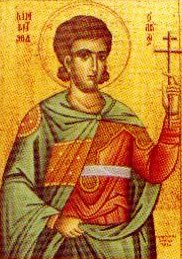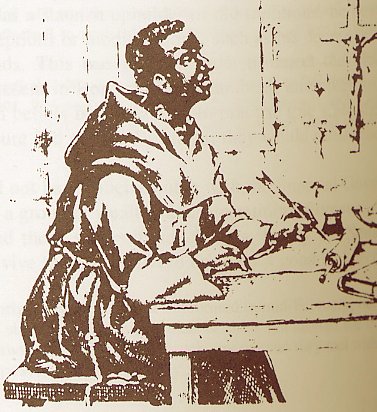ADDITIONAL INFORMATION SECTION 15
Black Africans of Rome have contributed greatly to the growth of Christianity and the development of the Roman Catholic doctrine. Three of the greatest scholars and founding theologians of Christianity were Black Roman Africans that included Tertullian, Cyperian, and St. Augustine, but the greatest contributions were clearly made by these three Black popes; Pope Victor I, Pope Miltiades, and Pope Gelasius I.
 Pope Victor I, the 14th pope, served from 189 AD - 199 AD. In 189 AD, there was major controversy regarding the date of Easter which was celebrated in Asia on the 14th day after the full moon. This fell on any day of the week and therefore meant that some Christians would have been celebrating Lent while others would have been celebrating the Resurrection, so Pope Victor I in a council held in Rome in 196, decreed that the Feast of Easter would be celebrated only on the Sunday after the 14th day of the moon of March, and any Asian Christians who defied this declaration would be excommunicated. From that point onwards, Easter was celebrated only on the Sunday.
Pope Victor I, the 14th pope, served from 189 AD - 199 AD. In 189 AD, there was major controversy regarding the date of Easter which was celebrated in Asia on the 14th day after the full moon. This fell on any day of the week and therefore meant that some Christians would have been celebrating Lent while others would have been celebrating the Resurrection, so Pope Victor I in a council held in Rome in 196, decreed that the Feast of Easter would be celebrated only on the Sunday after the 14th day of the moon of March, and any Asian Christians who defied this declaration would be excommunicated. From that point onwards, Easter was celebrated only on the Sunday.
Also, under the influence of the Black theologian Tertullian, Pope Victor I, who is now celebrated as a saint with his feast day of July 28th, declared that Greek would be replaced by Latin as the official language of the Church of Rome. Pope Victor was therefore the first to celebrate Mass in Rome using Latin, the common language of the people.
Pope Victor I also condemned and excommunicated Theodore of Byzantium for heresy after he enticed followers in Rome to deny the divinity of Jesus the Christ, preaching that Jesus was an ordinary man filled with supernatural powers through Baptism.
When Black Romans were in control of the world religiously with Victor and Tertullian, the Black Romans gained political and military control of the world in 193 AD, through the Black Roman African, Septimius Severus, who became the Roman Emperor. He did not forget his roots however, and made hefty donations to the city's poor, while also employing them in massive building projects. Septimius Severus, after whom the month of September was named, was seceded as emperor by his Black son Caracalla from 211 AD until 217 AD.
 Pope St. Miltiades or Mechiades, the second Black pope, served from 311 AD until 314 AD as the 32nd pope. Militiades decreed that none of the faithful should fast on Sunday or on the fifth day of the week, because this was the custom of the pagans. After taking office, Miltiades persecuted the Christians until he got an edict of toleration from Emperor Galerius to end such persecutions and allow the Christians to emerge from their underground caves. Pope Miltiades then convinced Emperor Maxentius to return all church buildings and possessions confiscated during the persecutions.
Pope St. Miltiades or Mechiades, the second Black pope, served from 311 AD until 314 AD as the 32nd pope. Militiades decreed that none of the faithful should fast on Sunday or on the fifth day of the week, because this was the custom of the pagans. After taking office, Miltiades persecuted the Christians until he got an edict of toleration from Emperor Galerius to end such persecutions and allow the Christians to emerge from their underground caves. Pope Miltiades then convinced Emperor Maxentius to return all church buildings and possessions confiscated during the persecutions.
It was also during the reign of Pope Miltiades that Emperor Constantine converted to Christianity after receiving a vision of the cross. Constantine's army marched into Rome in 312 AD and overthrew the oppressor Maxentius, and later made Christianity the authorized religion of the Roman Empire. Pope Miltiades was made a saint, and his feast was celebrated on December 10. The Black Roman theologian St. Augustine referred to Pope Miltiades as "an excellent pontiff, a true son of peace, and father of Christians."
 Pope Gelasius I, the 49th pope, was the third Black pope who came to office in 492 AD, (1,000 years before America was supposedly discovered). Born in Rome of African parentage, he was a member of the Roman clergy from a youth. Gelasius I devoted himself to uplifting the poor and the weak, even instructing his bishops to donate a quarter of their income to charity, emphasising that "nothing is more becoming to the priestly office than the protection of the poor and the weak."
Pope Gelasius I, the 49th pope, was the third Black pope who came to office in 492 AD, (1,000 years before America was supposedly discovered). Born in Rome of African parentage, he was a member of the Roman clergy from a youth. Gelasius I devoted himself to uplifting the poor and the weak, even instructing his bishops to donate a quarter of their income to charity, emphasising that "nothing is more becoming to the priestly office than the protection of the poor and the weak."
His contemporaries described him as "famous all over the world for his learning and holiness."
Pope Gelasius I was also credited with ending the pagan ritual of Lupercalia, a fertility rite celebration where young men would dress in skins and strike any woman they met with a whip, believing that it conferred fertility and chased away bad luck. He sternly asked why the gods they worshipped did not calm the seas so the ships transporting the grain could reach Rome in time for the winter. He replaced Lupercalia with the "feast of the purification of the blessed virgin" presently known as "Candlemas" and declared a day in honour of St Valentine.
Gelasius also wrote to a wealthy woman of rank, Femina, asking her to have the lands of St. Peter which were taken by the barbarians and the Romans returned to the church, since the lands were needed for the poor who were assembling in Rome. Gelasius I became very famous through his firm letter to Emperor Anastasius regarding the need for independence of church and state. He told the emperor that the world is governed by two great powers; that of the popes and that of kings; but the authority of the popes is so much greater because on judgment day, popes will have to render an account to God for the soul of kings. Gelasius I was made a saint and his feast day is held on November 21.
So, contrary to the belief held by many who refer to Christianity as a white man's religion, the facts clearly demonstrate that Christianity was founded by the genius of three Black theologians, and further developed and propelled by devoted contributions made by three Black Roman African popes.


The Bible was written by Africans about Africans, it is not about Europe or Europeans. In fact, Europe was not in existence 6,000 years ago. The Bible was translated not written by King James.
In 325, Constantine becomes the first Christian Emperor of Rome and convenes the first council at Nicea, Turkey, where Christianity was declared as the official state religion (333), while attempting to settle the Arian dispute regarding the nature of Jesus Christ. It was there that the doctrine of the Trinity was declared to be the orthodox Christian belief.
Christian Emperor Theodosius then bans the ancient religious systems of Egypt and orders the closing of all Egyptian temples. The last recorded date of Egyptian hieroglyphic inscriptions was in 394 B.C., and in 527 A.C. the Christian Emperor Justinian finally succeeded in closing the last Egyptian temple at Philae.
It was at the Council of Nicea, in 325 AD that;
- The Roman Sun-day or day of the Sun was declared to be the Christian Sabbath along with the worship of the sun being the official state religion.
- The emblem of the Sun god, the cross of light, was adopted as the emblem of Christianity.
- The date of Easter was established.
- Rules were framed that defined the authority of bishops, thereby paving the way for a concentration of power in ecclesiastical hands.
- By vote, Jesus was declared a god, not a mortal prophet.
A year after the Council of Nicea, Constantine authorized the confiscation and destruction of all works that opposed orthodox teachings referring to Jesus, including works by heretical Christians. He also arranged a fixed income to be to be paid to the Church, and installed the bishop of Rome in the Lateran Palace. It was not until 384 that the bishop of Rome called himself Pope for the first time. Later in A.D. 331, he commissioned and sponsored new copies of the Bible.
In A.D. 303, a quarter of a century earlier, the pagan emperor Diocletian had undertaken to destroy all Christian writings that could be found, and as a result Christian documents - especially in Rome - all but vanished. When Constantine commissioned new versions of these documents, it enabled the custodians of orthodoxy to revise, edit, and rewrite their material in accordance with their tenets as they saw fit.
It was at this point that most of the crucial alterations in the New Testament were probably made. Of the five thousand extant early manuscript versions of the New Testament, none predates the fourth century, in other words, the New Testament as it exists today is essentially a product of fourth-century editors and writers.
The following is an incomplete list of heathen, unscriptural practices that became part of the Roman Catholic doctrine over a period of seventeen centuries. In many cases, these heresies were even debated for years before being given the status of required beliefs.
Note that some of the dates given are approximate.
1. Prayers for the dead .....300 AD
2. Making the sign of the cross .....300 AD
3. Veneration of angels and dead saints .....375 A.D
4. Use of images in worship .....375 A D.
5. The Mass as a daily celebration .....394 AD
6. Beginning of the exaltation of Mary; the term, Mother of God applied at Council of Ephesus..431 AD
7. Extreme Unction (Last Rites) .....526 AD
8. Doctrine of Purgatory-Gregory I .....593 AD
9. Prayers to Mary and dead saints .....600 AD
10. Worship of cross, images and relics .....786 AD
11. Canonization of dead saints .....995 AD
12. Celibacy of priesthood .....1079 AD
13. The Rosary .....1090 AD
14. Indulgences .....1190 AD
15. Transubstantiation-Innocent III .....1215 AD
16. Auricular Confession of sins to a priest .....1215 AD
17. Adoration of the wafer (Host) .....1220 AD
18. Cup forbidden to the people at communion .....1414 AD
19. Purgatory proclaimed as a dogma .....1439 AD
20. The doctrine of the Seven Sacraments confirmed .....1439 AD
21. Tradition declared of equal authority with Bible by Council of Trent .....1545 AD
22. Apocryphal books added to Bible .....1546 AD
23. Immaculate Conception of Mary .....1854 AD
24. Infallibility of the pope in matters of faith and morals, proclaimed by the Vatican Council..1870 AD
25. Assumption of the Virgin Mary (bodily ascension into heaven shortly after her death) ...1950 AD
26. Mary proclaimed Mother of the Roman Catholic Church .....1965 AD

 |
 |
 |
 |
 |
[ White Man-Origin ] [ Black Gods ] [ Imhotep/Medicine ] [ Buddha ] [ JESUS ] [ Hercules ] [ Superman ]